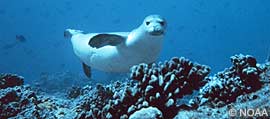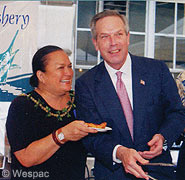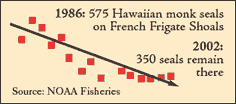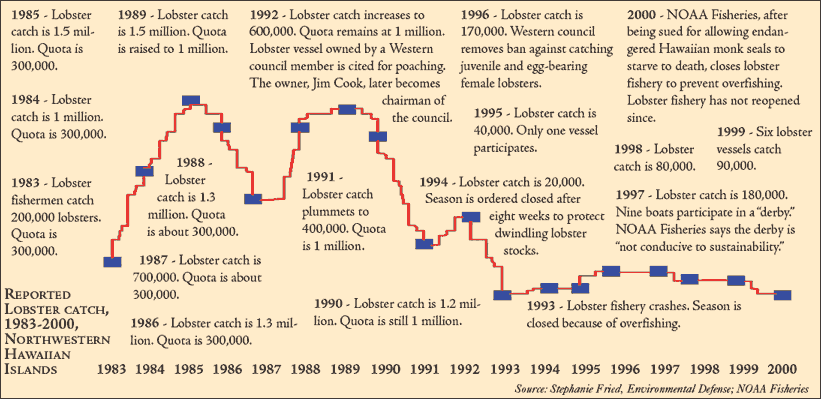

 |
||
 |
||
Vol. 6 (2): December 2003 |
Download this article
|
|
PLUNDERING THE PACIFICPaul KobersteinEditor of Cascadia Times |
The cats who run the fishhouse Western Pacific council pushes plan |
|
 |
|
|
An endangered Hawaiian monk seal swims near its home in the Northwestern Hawaiian Islands. |
“I am writing to ask for your help in reversing an ‘11th-hour decision’ by former President Clinton that will have a devastating economic impact on the fishing industry of Hawai‘i,” Linda Lingle, then a Republican candidate for governor of Hawai‘i, wrote in a letter two years ago to U.S. Commerce Secretary Don Evans.
That decision had created the Northwestern Hawaiian Islands Coral Reef Ecosystem Reserve, which protects up to 70 percent of the coral reefs in the U.S., culminating a century of preservation initiated by Republican President Theodore Roosevelt.
The Western Pacific Regional Fishery Management Council, or Wespac, headed by executive director Kitty M. Simonds, had convinced Lingle to send Evans a letter calling for the annulment of the Executive Orders which established the Coral Reef Ecosystem Reserve.
The letter, a copy of which was obtained by Cascadia Times, was written by the Western Pacific council as part of its campaign to undermine the historic reserve, and appears to be evidence that the council was willing even to distort the facts to achieve this end.
But seven months later, Lingle determined that the reserve had widespread support after hearing from a range of fishermen, fish processors, Native Hawaiian cultural practitioners, scientists and ordinary citizens who had united their communities to persuade the White House to protect the distant islands from the management abuses of Wespac and NOAA Fisheries. On Oct. 10, 2001, she sent a second letter to Evans, retracting her opposition to the reserve and urging him to go forward with it. She said she based her previous comment on a “less than complete understanding” of the issue. “After listening to individuals on both sides of the issue, I now urge you to allow the Executive Orders to stand…”
Lingle, now the governor of Hawai‘i, learned that Clinton’s order was no 11th-hour decision at all, but a well-considered judgment overwhelmingly supported by Hawaiians. Over the past three years, 26 federal and state hearings and scoping sessions have been held on the management of the Northwestern Hawaiian Islands. The public has responded with an outpouring of 52,000 letters of support for strong conservation measures. Only a tiny fraction — about 1 percent — of those who made a comment opposed the ecosystem reserve.
The council also told Lingle that the ecosystem reserve “will cause great negative socioeconomic impacts to the state of Hawai‘i.” They also said it could destroy all existing fisheries in federal waters off Hawai‘i that haven’t already been shut down by the courts for their impacts on endangered species.
None of this was true. The reserve allows existing fisheries to continue as they are. As for the economic impacts, they would be miniscule. No one fishes for lobsters anymore in the Northwestern Hawaiian Islands. Thanks to the council’s mismanagement, the small fishery was already closed, preventing the six Northwestern lobster vessels from setting traps. Only about nine boats participate in the commercial bottomfish fishery there. The Executive Order grandfathers in the existing and very small cadre of bottomfishers and the handful of recreational fishers who brave the rough northern waters.
To those who follow the Western council closely, information that it intentionally misled the soon-to-be-elected governor came as no surprise. They say Simonds has been misleading the public and policy-makers for years as she has attempted to maintain the healthy stream of appropriations flowing to her small Council for the “management” of NWHI fisheries, while catering to the handful of fishers who dominate the council and who over the years have played a major role in nearly driving to extinction two of the most endangered large animals on the planet: leatherback sea turtle and the Hawaiian monk seal.
“This is a story of a very small number of people holding 50 percent of U.S. ocean resources hostage,” says Stephanie Fried, a senior scientist for Environmental Defense, a conservation group. “It’s also a story of a popular uprising led by Native Hawaiian cultural practitioners, fishers, and environmentalists, all working together to protect one of the last great ecosystems on earth.”
 |
|
|
Kitty Simonds, executive director of the Western Pacific Fishery Management Council, serves marlin to Commerce Secretary Don Evans. |
After Bush took office, Simonds stepped up her campaign to dismantle the new Coral Reef Ecosystem Reserve. With each fishery shut down by the reserve, the council stands to lose federal dollars appropriated for managing each of those fisheries. Her agenda called for maintaining the council’s cash flow by setting up a commercial industry to collect deep sea corals, and to harvest fish in the fragile and shallow coral reef areas surrounding remote atolls and islands, under a “coral reef ecosystem” fishery plan. The Executive Order creating the reserve does not allow these actions, but Simonds and the council are now trying to weaken the order.
“It is such a perverse thought that the result of President Clinton’s actions to protect the coral reefs of the Northwestern Hawaiian islands would result in industrial exploitation and harvesting in these very coral reefs,” says Ellen Athas, who worked at the Clinton White House on ocean issues.
“The coral reefs take so long to grow — you look at 4 inches and it’s taken 400 years to get there. Scientists tell us what magic they contain for us.”
When the White House looked at the Northwestern Hawaiian Islands for the first time, Athas said it saw an area rich in resources in a relatively pristine condition. “The only people who would battle against it are maybe a dozen fishermen. We never get the opportunity anymore to see these places. Other places everything is developed, the hotels are in place and the corals are all gone.”
Athas is not alone in finding it unfathomable to think that anyone would oppose the reserve other than those who play power politics or are somehow connected to the jewelry industry.
Of course, many people would find it unfathomable to learn what Wespac did to the Hawaiian monk seal.
The seal’s main breeding grounds lie in the most isolated archipelago on earth, the Northwestern Hawaiian Islands, stretching 1,200 nautical miles from the Main Hawai‘i Islands to Kure Atoll.
The Northwestern Islands are also home to millions of seabirds and rare green sea turtles, as well as 70 percent of all coral reefs in the U.S.
During the last two decades, a frightening crash in the number of monk seal pups has put the species in jeopardy. In a word, the pups are starving.
In the 1800s, hunters decimated the population. In 1909, Republican President Theodore Roosevelt issued an Executive Order to protect the Northwestern Hawaiian Islands and establish a wildlife refuge system there. Since it was listed as endangered in 1976, the seal’s population crashed once again. In the 1970s, about 90 percent of seal pups survived to adulthood. Two decades later, only about 10 percent survived.
Biologists say the total population is now only 1,400. The monk seal is now considered to be highly endangered to the point that a natural catastrophe could lead to extinction.
In 1999, three conservation groups — Greenpeace Foundation, Center for Biological Diversity, and Turtle Island Restoration Network — successfully sued to stop Wespac from allowing the small but high-impact 6-boat lobster fishery to continue to decimate lobsters. The groups also cited the council’s high-impact but small bottomfish fishery around the islands as a cause. “The data strongly suggest that the [lobster] fishery contributes to the starvation of the monk seals,” the federal judge in the case ruled.
The council denied — and denies today — that its lobster fisheries starved the monk seal pups. But a growing number of scientific reports say otherwise.
In 1983, the federal monk seal recovery team called for studies to determine how much of the seal’s food was being caught by fishers. In 1991, biologists with the U.S. Marine Mammal Commission called on NOAA Fisheries to halt the lobster catch, and it did. In 1993, NOAA Fisheries reopened lobster fishing, and, 424,000 lobsters were caught.
Between 1997 and 2000 the annual lobster catch ranged between 200,000 and 300,000.
During these years, as monk seal populations plummeted, the Marine Mammal Commission again and again repeated its call for a halt to the lobster fishery. They wrote more than twenty letters between 1991 and 2000 expressing deep concern. But the Western council kept responding by saying, “Bugger off — there is no scientific proof here,” says Paul Achitoff, an Earthjustice attorney who represented the conservation groups. “They said they weren’t going to take any action to protect the monk seal.”
In 1999, the Hawaiian Monk Seal Recovery Team, concerned about the declining colony at French Frigate Shoals, recommended closing the lobster fishery for three years to allow stocks to recover.
The council refused that request. Instead, it set a lobster quota of up to 200,000. The council emphatically stated that the lobster had not been overfished. But in April 2000, NOAA Fisheries shut lobster fishing down, and has not reopened it since. It noted a lack of appreciable rebuilding despite significant reductions in fishing. In December 2000, NOAA attributed the decline “to some degree” to the lack of lobsters and starvation.
At the same time, a federal judge ruled the agency had failed to fulfill its “rigorous” obligation to insure that lobster fishing did not jeopardize the seals.
The lesson for fishery managers, says Achitoff, is that they “shouldn’t be authorizing a fishery to take food away from endangered species.”
In December 2000, almost a century after Roosevelt’s visionary protection measures, President Clinton designated the islands as the Northwestern Hawaiian Islands Coral Reef Ecosystem Reserve. As Lingle wrote in her second letter to Evans, Hawai‘i’s fishermen, native cultural practitioners, and ordinary citizens helped designed the reserve “in such a way to protect both jobs and the environment”. “It was one of the greatest outpourings of public participation and support for a natural resource decision ever in Hawai‘i”, said Cha Smith, director of KAHEA, a grassroots organization based in Honululu that’s been at the forefront of advocating broad public involvement on the issue.
One of those who helped design the reserve, Isaac Harp, a native fishermen, said the group initially hoped to place management of the area under the Department of the Interior, which has a better conservation record than Commerce. But pressure from Hawai‘i’s powerful Democratic senator, Daniel Inouye, and others, put the reserve under the jurisdiction of the Department of Commerce. Wespac has apparently had a history of direct and swift access to Senator Inouye’s office whenever a federal bureaucrat gives them trouble.
“Our initial effort was to get national monument status under the Department of Interior,” says Isaac Harp, a Native Hawaiian fisherman who served on the State’s Bottomfish Task Force. “But Inouye opposed a monument. So they came up with an agreement to make it a National Marine Sanctuary. In national monuments everything is prohibited unless specifically allowed. Under a sanctuary everything is allowed unless specifically prohibited.”
The Main Hawaiian Islands are among the most visited places on earth. They are one of the few places left where it is easy to snorkel, dive or swim to view the green sea turtles that migrated from their Northwestern Hawaiian Islands breeding grounds, an important component of Hawai‘i’s $800 million ocean recreation industry.
The distant and fragile Northwest Islands, identified by scientists as the last large-scale coral reef wilderness remaining on the planet, are home to unmatched biodiversity. Native Hawaiians call this vast 1,200 mile region a “pu‘uhonua” — a place of refuge and safety — for animals that can no longer be found in the Main Islands. Sacred sites abound in the islands.
Conservationists say Clinton’s mistake was to put the islands under the Department of Commerce’s National Ocean Service, which has allowed bottom trawlers to damage National Marine Sanctuaries elsewhere. The Department also houses Wespac.
So far, the Department of Commerce has failed to enforce the Executive Orders, and bottom fishing has increased 17 percent, according to Wespac. One of Wespac’s new members, Sean Martin, was a lobster fisherman in the Northwest Islands for 16 years before it was ordered closed.
Martin said at a public hearing that the lobster fishery “is one of the most tightly controlled and managed fisheries in the country… It is unfortunate… the President has chosen to take regional management out of the region and have a resource managed by those who for the most part have never been there.”
But Louis “Buzzy” Agard, native Hawaiian fisherman, a lobster processor and an original member of the Wespac council, said the lobster fishermen have only themselves to blame for destroying the fishery. “If you are a council member and have an interest in lobster catches and boats, you shouldn’t be voting to continue when you have the scientists telling you it’s dangerous.”
 |
|
|
|
In the 1980s the monk seal’s largest colony at major rookeries began a long decline (chart at right). By 2000, two thirds of the seals at French Frigate Shoals were gone. Chart below shows the rise and fall of the lobster fishery, 1983-2000. Many scientists believe seal pups starved to death because a handful of fishers had killed too many lobsters. The total catch these years was more than 10,270,000 lobsters. The catch was nearly 4 million above the quota from 1983 to 1992, when it crashed.
 |
Copyright © 2003 Paul Koberstein, Cascadia Times. The Monachus Guardian. All Rights Reserved |